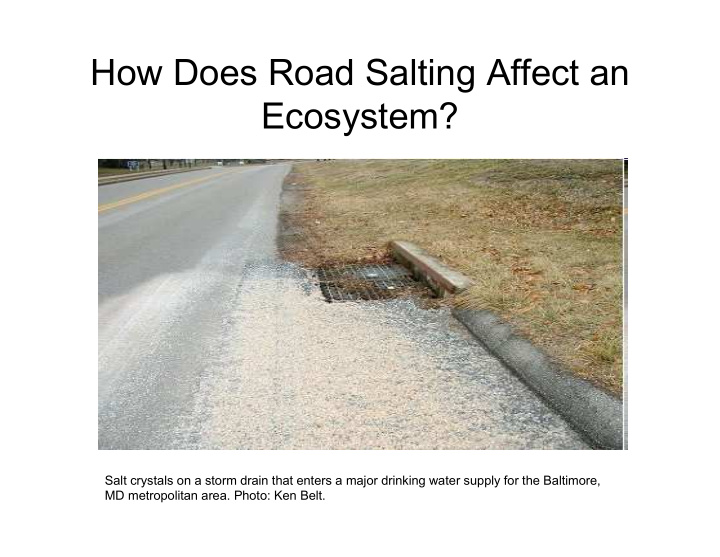



How Does Road Salting Affect an Ecosystem? Salt crystals on a storm drain that enters a major drinking water supply for the Baltimore, MD metropolitan area. Photo: Ken Belt.
Predict: “I think…” “It affects animals by…” “It affects PEOPLE by…” “It affects plants by…”
A team of scientists in Maryland are discovering that salt from de-icers is becoming a large threat to freshwater ecosystems in our area. From: http://media-2.web.britannica.com/eb- media/90/77990-004-59C9E845.jpg
Not only have they been finding these salts in freshwater streams and rivers, but the highest amounts occur in watersheds with the MOST roads and parking lots! From: http://ecotope.org/projects/projects_images From: /ws263_aerial_view_2005.jpg http://www.baltimorecountymd.gov/Ag encies/environment/watersheds/ep_gw ynnsmain.html
When there is snow or ice on the ground, de-icers work to melt the ice to make it safer to drive on the roads. Sidewalks are also treated with these salts to keep people from slipping on the ice. From:http://farm4.static.flickr.com/3002/2341303856_0a8 From: 31f0fa6_o.jpg http://weblogs.baltimoresun.com/news/local/bay_environm ent/blog/salttrucksun.jpg
The research shows that in areas that have greater amounts of impervious surfaces also have the greatest amounts of salts in the water. From: www.talesfromurbanforests.org
In forested areas that have a lot of pervious surface, scientists do not measure a lot of salt in the waters. From: http://photos3.meetupstatic.com/photos/event/e/1/1/1/highres_6357617.jpeg
In Baltimore city, an urban area with mostly impervious surfaces, the amount of salt in the water is extremely high. From: http://www.city-data.com/picfiles/pic385.php
As more construction occurs, and more roads get built, what do YOU think happens to the amount of salt in the water? ↑ • Does it increase? • Does it DECREASE? ↓
Scientists use graphs to look at data and to make predictions. What do you see in this graph? (Replace BES graph with simplified version later…)
Notice that: • There are more impervious surfaces in urban areas than in suburban or rural areas. • The higher the amount of impervious surface in an area, the higher levels of salts there are. • SO…
The amount of salts INCREASES! ↑
BES Stream Sampling Areas (Image from: http://www.ecostudies.org/bes/frame4-page_3f_05.html)
Now, use your models to compare the location of our school to where the data is being collected. • Are we in a ����� , �������� or ����� area? • Do we have more or less impervious surfaces? • Do we have more or less salts in our water?
We live in an urban area in Baltimore city. We have a large amount of impervious surfaces in our neighborhood. Therefore, scientists have measured a lot of salts in our water.
How do think this affects the animals in your neighborhood? Amounts greater than 250 mg/L of salt causes death in animals. ←
How do you think this affects the plants in your neighborhood? Amounts greater than 50 mg/L of salt causes damage to the plants. ←
How do you think this affects YOU? (Insert Fig.1 “Drinking Water Supply to Baltimore, Maryland” from S.S. Kaushal” paper.)
What can you do about it? • Help to plant more trees in your neighborhood. That way, you are creating more pervious surfaces in your community.
What can you do about it? • Help to create gardens and green spaces in your neighborhood. This way, less salt will get washed into our storm drains.
What can you do about it? • Tell others to help you!
Recommend
More recommend